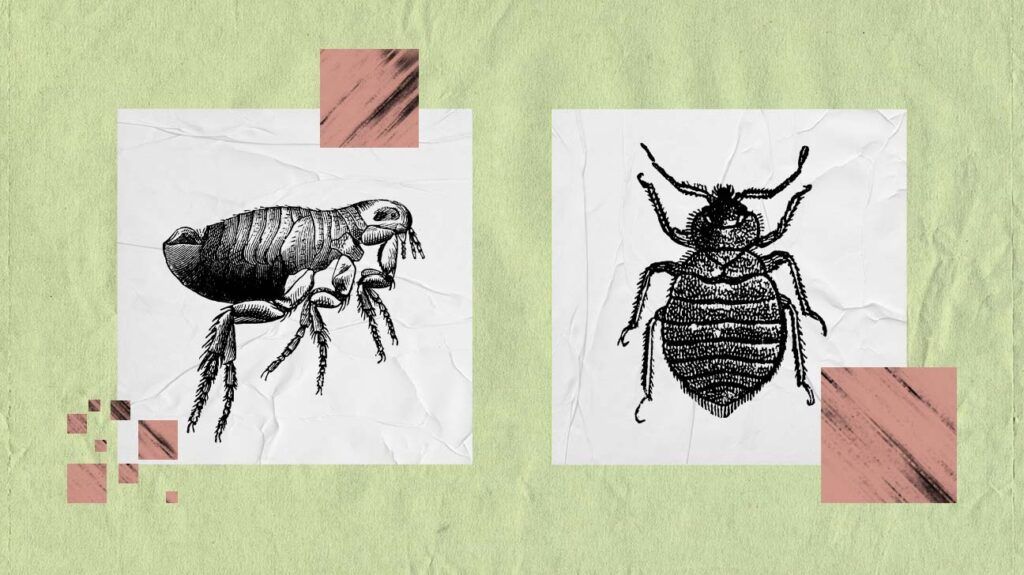Both bedbugs and fleas can leave multiple bites. Flea bites are typically highly itchy, while bedbug bites may not itch at all.
Fleas commonly live on pets, such as cats and dogs, but they can also bite humans and cause itchy, swollen bumps.
Bedbugs are also common, especially in communal living environments such as nursing homes and hotels.
Fleas can transmit some diseases, such as flea-borne typhus, while bedbugs do not typically spread disease.
People with allergies may have intense reactions to bites, and some even develop infections. In most households, however, fleas and bedbugs are an inconvenience, not a real danger.
Distinguishing between fleas and bedbugs is key to getting rid of them. Read on to learn how to identify different bites and what to do next.

Fleas
Although fleas do not live on humans, they may bite people if they have the chance after jumping off a host. In humans, flea bites generally appear on the legs and ankles.
Although there are
These bedbugs prefer to eat the blood of humans and take up residence in beds and other places that give them easy access to human blood. They cannot jump or fly.
Bedbugs are nocturnal, meaning they feed at night when the person is asleep.
The table below shows some key differences between flea bites and bedbug bites.
| Fleas | Bedbugs | |
|---|---|---|
| Bite symptoms | Flea bites cause small bumps with a dark red center that tend to be itchy. | Bedbug bites may appear as small hives measuring around |
| Bite pattern | Bites can appear in clusters and linear patterns, | Bites can also appear in clusters and linear patterns of three or more bites. |
| Bite frequency | Fleas bite whenever they get the chance. | Bedbugs tend to feed every few days when the person is sleeping deeply, often between 1:00 and 5:00 a.m. |
Other bites
Fleas and bedbugs are not the only creatures that can bite. Some signs that something else might be the culprit include the fact that:
- There is only one bite: A single bite could indicate a spider bite or an ant bite.
- There are several pink, swollen bites in different areas: This might indicate mosquito bites. Some mosquitoes,
including the species that carries the Zika virus, may live indoors. - The area is painful and swollen or has a stinger in it: This could indicate a bee sting or a sting by another stinging insect.
This section examines pictures of flea and bedbug bites.
People who experience bedbug bites do not necessarily have bedbugs living in their homes. For example, bites may occur after a trip to a house or hotel with a bedbug infestation.
However, if someone has stayed in a location with bedbugs, they may likely have brought some home.
Some signs of a bedbug infestation in the home
- Visible bedbugs: These may appear as tiny bugs or dots in the folds of sheets or pillowcases or in the seams of a mattress.
- Bedbug exoskeletons: These crunchy-looking bedbug shells may be visible in or around the bed.
- Bedbug feces: These tiny, rust-colored spots may appear on the sheets or mattress.
- An unusual odor: There may be a sweet or musty odor coming from the mattress or sheets.
Some signs that there are fleas in the home include:
- Visible fleas: There may be visible fleas on a family pet or tiny jumping insects in the home.
- Visible flea eggs: These clear or white grains may be visible on the pet’s fur.
- Visible flea feces: These dark black “grains of sand” specks may be visible in a pet’s fur or on their bedding.
- Changes in the pet’s behavior: The pet may become unusually itchy or anxious.
It is important to note that both fleas and bedbugs can be present in a home at the same time.
After discovering a flea or bedbug bite, a person may want to treat the bite. If an infestation is present, a person then needs to treat the infestation.
Treating the bites
Bedbug bites and flea bites rarely require treatment. However, some people may choose to apply an over-the-counter hydrocortisone cream to soothe the discomfort.
People need to avoid scratching the bites, as this can cause further skin irritation.
It is also important for a person to consult a doctor if they develop any symptoms of an infection. These symptoms include fever or intense pain and swelling around the bite.
Treating the infestation
Exterminators are not usually necessary to eliminate a flea infestation. People with pets can contact a veterinarian to explore options for killing fleas and flea eggs on a pet.
Because fleas prefer to live on furry animals, they usually die shortly after the pet receives treatment. Thoroughly vacuuming and washing the pet’s bedding in hot water can help eliminate flea eggs.
If the fleas do not disappear after treating the pet, or if there is no pet, people need to contact an exterminator.
The exterminator will establish whether or not fleas really are the culprit. They will then decide on the appropriate treatment for the home.
Bedbugs are generally harmless to people and cannot spread disease. Some fleas carry diseases
Both fleas and bedbugs can be a serious annoyance, but in most cases, a few simple home treatments can rid the home of the insects.
Because exterminating these pests requires the use of toxic pesticides, the safest option is to work with a professional.
It is best to ask a veterinarian about the safest way to kill fleas and consult an exterminator about safely eliminating bedbugs from the home.
